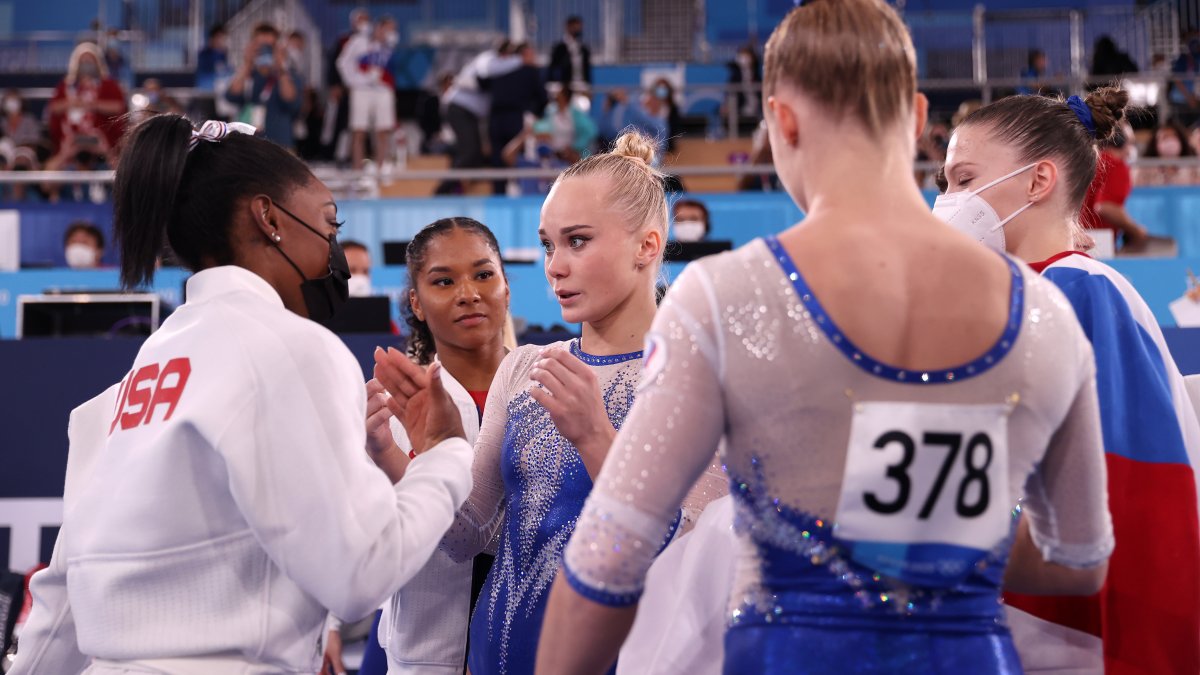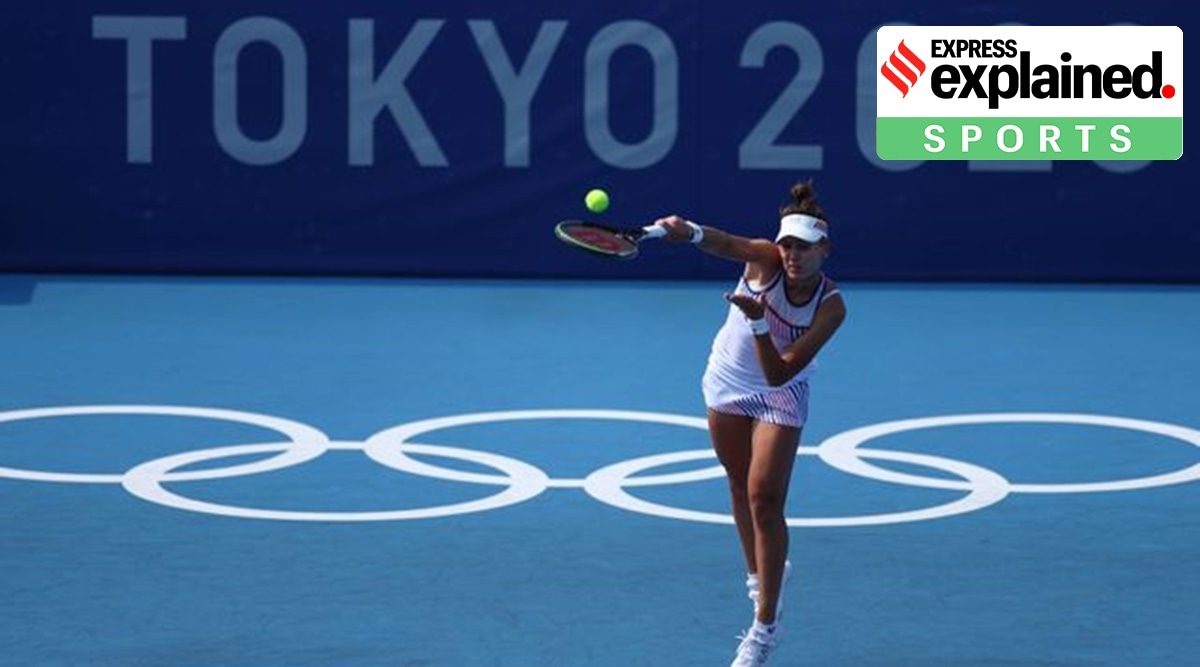Who is ROC in the Olympics? How Russian Athletes are Competing in Tokyo
 ]
]
Viewers may have noticed an unfamiliar country abbreviation at the Tokyo Olympics: ROC.
Athletes from Russia took home gold in the women’s team gymnastics event, beat the U.S. men’s volleyball team and made headlines in several events. But how is that possible given the country’s ban?
Here’s a breakdown of what ROC means and how Russian athletes are competing in the Games:
What is the Russian Olympic Committee?
Just who is the ROC, anyway? It stands for Russian Olympic Committee.
Our redesigned local news and weather app is live! Download it for iOS or Android — and sign up for alerts.
Is the ROC the same as Russia?
Well, sort of. Russia received a two-year ban from the World Anti-Doping Agency for its state-sponsored doping program. Between December 17, 2020, and December 17, 2022, no athlete can represent Russia at the Olympics, Paralympics or World Championships.
The ban was originally set to last four years, but the Court of Arbitration for Sport reduced it to two years. The state-sponsored doping program was revealed in 2016 and included at least 15 medal winners from the 2014 Olympics, held in Sochi, Russia.
Athletes competing under the ROC designation cannot wear the Russian flag, or any other national symbol, on their uniforms. If their uniforms say “Russia,” they must also include “neutral athlete” or something equivalent in the same size.
When an ROC athlete wins a gold medal, the Russian anthem will not be played. Vitalina Batsarashkina won the ROC’s first gold in Tokyo in the 10m pistol event earlier Sunday. She was serenaded by music from Tchaikovsky’s Piano Concerto No. 1, which will also play for other ROC gold medalists.
Will Russia compete at the 2022 Olympics in Beijing?
The ROC will be competing instead of Russia at the Winter Olympics in Beijing in February 2022. Russia was also under sanctions for the 2018 PyeongChang Olympics, where athletes were considered “Olympic Athletes from Russia.”
Unless further sanctions are levied, the traditional contingent from Russia, including its flag and anthem, will be back at the 2024 Olympics in Paris.
WATCH — Why can’t Russia compete as a country at the 2020 Tokyo Olympics?
 ]
]
The story behind the ROC
Have you seen the letters R-O-C popping up at the top of the medal count boards at this year’s Olympic Games?
Have you wondered what it stands for?
It’s not the short form for a country. In fact, it’s a compromise between the IOC — the International Olympic Committee — and a nation that got into some hot water for disobeying some pretty serious sports rules.
Abigail Dove explains the shocking story behind ROC
It’s the story of how one country managed to get caught in a sports cheating scandal that shocked the world.
Watch the latest Kids News Explains video to learn who the ROC are and why.
In this video:
0:27 — What does the ROC stand for?
0:47 — What did Russia do to get in trouble?
1:23 — What are the rules for the ROC?
The Refugee Olympic Team
The ROC isn’t the only odd team code you may have noticed.
The EOR is the code for another non-nation team, the Refugee Olympic Team. The code is based on the French name: Equipe Olympique des Réfugiés.
Refugees are people who had to leave their home countries to escape war, violence, conflict or persecution, according to the United Nations.
The opening ceremony flag bearers for the EOR were swimmer Yusra Mardini and marathon runner Tachlowini Gabriyesos. Mardini fled Syria due to the civil war. Gabriyesos left Eritrea when he was 12. He hasn’t seen his family in eight years. (Image credit: Franck Fife/AFP/Getty Images)
The EOR team in Tokyo is made up of 29 athletes to compete across 12 different sports.
The athletes currently live and train in a variety of host countries, including Canada.
This is the second time the EOR has been represented at the Olympics. The first time was at the 2016 Rio Olympics.
Day 4 highlights
Canada’s women’s softball team won bronze by beating Mexico.
The win secured Canada’s first-ever medal in the sport.
Naomi Osaka is out. Japan’s tennis star was knocked out of the women’s single tournament — with no chance to win a medal.
American Simone Biles —“The Goat” — withdrew from the women’s team artistic gymnastics final due to a “medical issue.”
Triathlete Flora Duffy swam, biked and ran her way to Bermuda’s first-ever gold medal.
Day 4 in pictures
Members of Canada’s women’s softball team embraced after their bronze win. Softball will not be returning to the Olympics in 2024. (Image credit: Yuichi Masuda/Getty Images)
Flora Duffy had a lot to smile about as she ran across the finish line of the women’s triathlon. In that moment she won her country of Bermuda’s first Olympic gold ever. (Image credit: Cameron Spencer/Getty Images)
Surfers like Brazil’s Italo Ferreira (pictured) battled intense waves during the men’s shortboard gold medal final. Ferreira would go on to win that Olympic gold, the first ever awarded in this debut Olympic event. On the women’s side, American Carissa Moore won the gold. (Image credit: Yuki Iwamura/AFP/Getty Images)
Japanese superstar Naomi Osaka was knocked out of the women’s singles tennis tournament by Marketa Vondrousove of Czech Republic. Osaka is currently ranked second in the world. Australia’s Ash Barty and Aryna Sabalenka of Belarus have also lost, which means the top three women in the world won’t be playing for a medal. (Image credit: David Ramos/Getty Images)
New Kids News Olympics content every day
CBC Kids News will be covering the Olympics every day until the closing ceremony on Aug. 8.
Some of the key events to look forward to on July 28 include both the men’s and women’s bronze and gold medal 3X3 basketball games.
Plus, the opening round of baseball and men’s golf.
Check back tomorrow to learn even more about the Tokyo 2020 Games.
With files from Christine Rankin, Devin Heroux/CBC
TOP IMAGE CREDIT: Patrick Smith/Getty Images, design by Philip Street
Tokyo Olympics: Why are Russians competing under the name ‘ROC’?
 ]
]
Veronika Kudermetova of the Russian Olympic Committee in action during her first round match against Garbine Muguruza of Spain. (Reuters Photo)
At the 2020 Tokyo Olympics, there are 335 sportspersons from Russia competing with athletes from around the world. Yet, unlike their counterparts, the Russians are not allowed to use their country’s name, flag, and anthem, and are competing under the acronym ROC, which stands for Russian Olympic Committee.
In the 2020 medals tally, all of their medals are listed next to the name ROC, with a flag that is different from Russia’s official.
Also in Explained | How a team of refugee athletes made it to Tokyo Olympics
This is because Russia, which has historically been among the world’s top sporting nations, has been ‘banned’ from the Tokyo Olympics.
What led to Russia being ‘banned’ from Tokyo Olympics 2020?
In December 2019, the World Anti-Doping Agency (WADA) banned Russia for four years from competing in international events, including the Tokyo Olympics and the FIFA World Cup in 2022. The ban was enacted after new revelations came up about a doping programme that Russia had been accused of.
For many years, whistleblowers and investigators had accused Russia of running a doping programme so sophisticated that it forced international federations to stop its athletes from competing in major events.
In September 2018, after multiple investigations, WADA lifted the sanctions on the condition that Russia hand over athlete data from its Moscow laboratory to doping regulators, which would help identify hundreds of athletes who may have cheated across various sports.
Russia was then accused of manipulating that database, leading to the WADA panel suggesting the four-year ban.
What was Russia originally accused of?
In 2014, 800m runner Yulia Stepanova and her husband Vitaly, a former employee of the Russian Anti-Doping Agency, RUSADA, appeared in a German documentary and lifted the lid on what was later described as one of the most “sophisticated doping programmes” in sports history.
Two years later, another whistleblower — Grigory Rodchenkov, a former head of the RUSADA — told The New York Times that Russia ran a carefully planned, state-sponsored doping scheme. Rodchenkov’s claims were more damning.
He alleged a wider conspiracy, in which the country’s anti-doping and members of intelligence services substituted urine samples of the athletes through a hidden hole in the wall at the agency’s laboratory during the 2014 Sochi Winter Olympics. The lab, according to investigations, was guarded by members of Russia’s state security services.
Subsequently, the International Olympic Committee (IOC), WADA and other global federations launched a series of investigations.
What did these authorities do then?
Immediately after the allegations surfaced, the accreditation of Russia’s anti-doping lab was suspended in 2015. After the preliminary investigations, the IOC removed 111 athletes, including the entire track and field team, from Russia’s 389-member contingent for the Rio Olympics.
Following a deeper inquiry, the IOC suggested a complete ban on Russia’s participation at the 2018 Winter Olympics in Pyeongchang, South Korea.
Ultimately, 168 athletes participated through special dispensations from the international federations. But the Russian Olympic Committee was barred from attending the event and the country’s flag was not officially displayed at any of the venues. Russian athletes, too, were forced to wear neutral uniforms with “Olympic Athlete From Russia” printed on them.
What happened then?
In 2020, the Court of Arbitration for Sport (CAS) reduced the initial ban of four years to two, but it ensured that no official Russian team can participate in events organised by a WADA signatory until the sanction term ends on December 16, 2022.
This means that official Russian teams are out of the 2020 Summer Olympics, next year’s Paralympics in Tokyo as well as the Beijing Winter Olympics. Even at the 2022 World Cup in Qatar, Russia would have to compete under a neutral name, if it qualifies. Russia is also not allowed to host any world sporting event whose governing body is registered with WADA during the ban period.
According to a report in The Independent, Russia will be reinstated after the ban term ends, if it respects and observes all imposed sanctions, pays its fines and contributions, and starts adhering to WADA regulations.
Newsletter | Click to get the day’s best explainers in your inbox
But what does the ‘ban’ effectively mean?
The ban is not outright, and 335 athletes from Russia are still playing at Tokyo, only under the name ROC, meaning Russian Olympic Committee – the team that sends Russian athletes to all Games. In effect, the ‘punishment’ only consists of forcing them to not use Russia’s name, flag or national anthem.
WADA President Witold Bańka said about the case to USA Today, “We at WADA remain disappointed that CAS has decreased the level of the sanctions from four years to two years and that CAS allows them to compete Russian athletes with the colours of the flag in the uniforms.”
The ROC players are only those who have been able to prove that they were not part of the doping scam. As per the IOC, “All public displays of the organisation’s participant name should use the acronym ‘ROC’, not the full name “Russian Olympic Committee”.
If on the kit of any athlete the name ‘Russia’ is written, the words ‘neutral athlete’ must also be written. However, the athletes will still be wearing uniforms in the country’s colours, as per IOC guidance, the Independent report said.